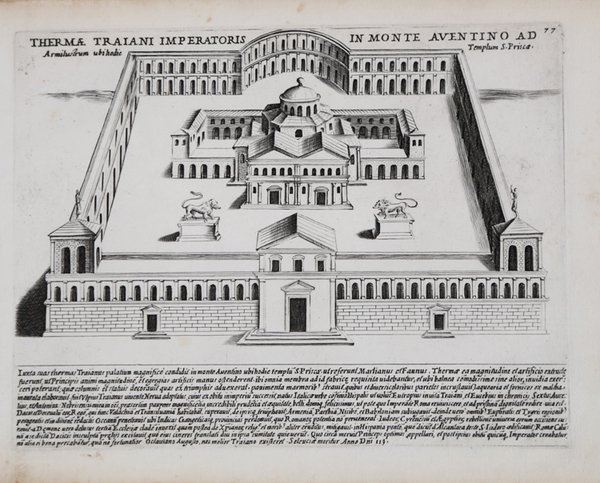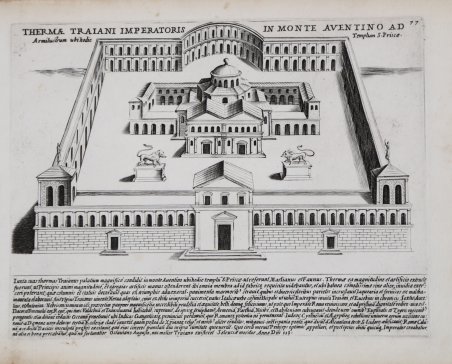Tavola tratta dal celebre Antiquae urbis splendor di Giacomo Lauro, opera di grande importanza storica e archeologica che l’autore iniziò nel 1612. Il titolo intero è: Antiquae urbis splendor, hoc est praecipua eiusdum templa, amphitheatra, theatra, circi, naumachie, arcus triumphales, mausolea aliaque sumptuosiora aedificia, pompae item triumphalis et colossaearum imaginum descriptio; opera & industria Iacobi Lauri Romani in aes incisa atque in lucem edita. Addita est breuis quaedam et succincta imaginum explicatio in qua regum consulum imperatoruq; res gestae et rei romanae origo progressus incrementum, ac finis cu almae urbis antiquor. ac modernor. vestigior. additione utcunq; hoc insequenti anno 1630 reperiutur, et ex veteru ac recentior. historiar. monumentis clare ostenditur. Il libro ha una lunga e varia storia di pubblicazione, a partire dal 1612, anche se il lavoro di Lauro sul libro precede la sua pubblicazione di almeno diciotto anni. Il libro fu stampato per la prima volta da Giacomo Mascardi, e originariamente conteneva solo due parti, anche se nel 1615 si era allargato a una terza parte. La prima parte conteneva 37 incisioni, con una dedica al re Sigismondo III di Polonia, datata 1614, e un ritratto datato 1609 (preso in prestito da un altro libro di incisioni). La seconda parte conteneva un ritratto di Carlo Emanuele I, duca di Savoia, datato 1613, e 41 incisioni. Vale la pena notare che questi primi due libri erano entrambi dedicati alla nobiltà polacca, probabilmente a causa del fatto che Lauro aveva goduto di patrocinio dall'incisione di battaglie polacche all'inizio della sua carriera. La terza parte, aggiunta più tardi, era dedicata a Ranuccio Farnese, uno dei maggiori mecenati di Lauro più tardi nella sua vita, e conteneva 40 incisioni. Il numero di tavole incluse in ciascuna delle precedenti edizioni dell'opera di Lauro (stampate alla Camera Apostolica nel 1614 in quattro parti, e stampate di nuovo lì nel 1621 in tre parti) fu finalmente stabilito nel 1628 con l'aggiunta del quarto e ultimo libro per un totale di 166 incisioni, che è il numero generalmente accettato per quante incisioni totali Lauro produsse per quest'opera. L'edizione pubblicata da Vitale Mascardi e curata da Giovanni Alto uscì nel 1637. Alto ha aggiunto un indice finale e numerato ciascuna delle incisioni, 2-167, per quest'ultima edizione. Incisione in rame, stampata su carta vergata coeva, con margini, in ottimo stato di conservazione. Plate taken from the important Antiquae urbis splendor by Giacomo Lauro. The full title is: Antiquae urbis splendor, hoc est praecipua eiusdum templa, amphitheatra, theatra, circi, naumachie, arcus triumphales, mausolea aliaque sumptuosiora aedificia, pompae item triumphalis et colossaearum imaginum descriptio; opera & industria Iacobi Lauri Romani in aes incisa atque in lucem edita. Addita est breuis quaedam et succincta imaginum explicatio in qua regum consulum imperatoruq; res gestae et rei romanae origo progressus incrementum, ac finis cu almae urbis antiquor. ac modernor. vestigior. additione utcunq; hoc insequenti anno 1630 reperiutur, et ex veteru ac recentior. historiar. monumentis clare ostenditur. The book has a long and varied history of publishing, beginning in 1612, though Lauro’s work on the book predates its publishing by at least eighteen years. The book was first printed by Giacomo Mascardi, and it originally only contained two parts, though by 1615 it had expanded to a third part. The first part contained 37 engravings, with a dedication to King Sigismund III of Poland, dated 1614, and a portrait dated 1609 (borrowed from another book of engravings). The second part contained a portrait of Charles Emmanuel I, Duke of Savoy, dated 1613, and 41 engravings. It is worth noting that these first two books were both dedicated to Polish nobility, probably due to the fact that Lauro had enjoyed patronage from engraving Polish battles early in his career. The third part, added later, was dedicated to Ranuccio Farnese, one of Lauro’s greater patrons later in his life, and contained 40 engravings. The number of plates included in each of the earlier editions of Lauro’s work (printed at the Camera Apostolica in 1614 in four parts, and printed there again in 1621 in three parts) was finally settled in 1628 with the addition of the fourth and final book for a total of 166 engravings, which is the generally accepted number for how many engravings total Lauro produced for this work. The edition published by Vitale Mascardi and curated by Giovanni Alto was released in 1637. Alto added a final index and numbered each of the engravings, 2-167, for this latest release. Copperplate, printed on contemporary laid paper, with margins, good condition. ' Cfr. Rossetti, Rome: A Bibliography. Vol. 3. (2000) p. 39-40.; Buckley, The Splendors of Ancient Rome: A Seventeenth Century View. The Splendors of Ancient Rome (1974); Laura Di Calisto, Lauro Giacomo in Dizionario Biografico Degli Italiani_ Vol. 64. (2005).


Find out how to use
Find out how to use

